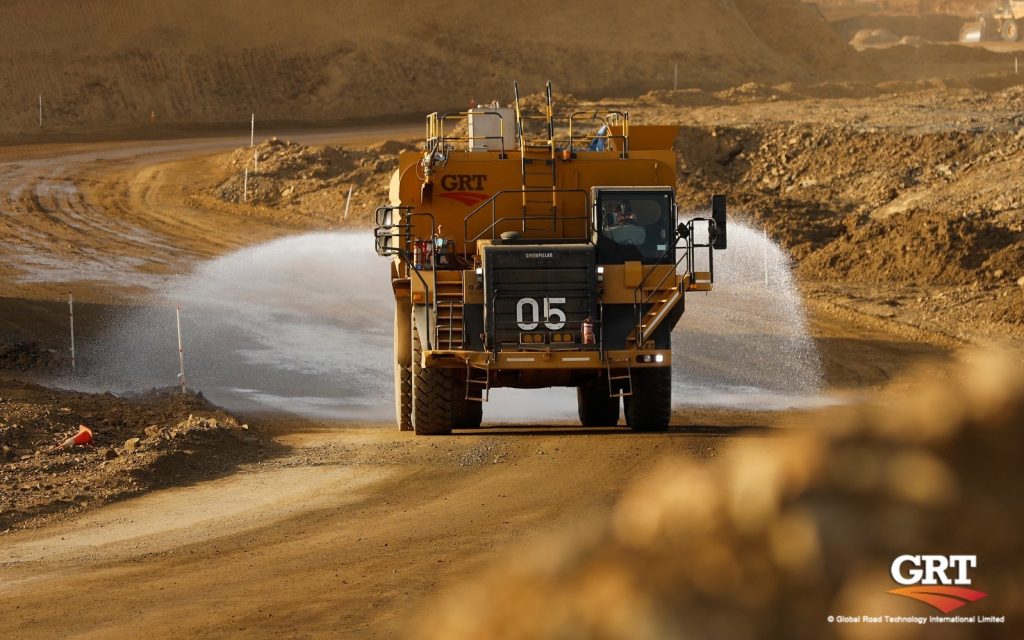Gold Coast, Australia – Dust control specialists Global Road Technology (GRT) is making automation a core focus of its product offering for the mining sector worldwide with its SMART Dosing Units (SDU) being launched globally as governments call for tighter controls around dust pollution.
Tested in some of the world’s harshest environmental conditions on mine sites in the Australian outback, the SMART (sustainable, mining, autonomously, reporting technology) Dosing Units are now seeing action in countries across Africa, Mexico and Brazil as mining companies seek to better manage haul roads through more efficient dust control methods.
Designed and assembled by GRT’s engineers, these Australian Made SMART Dosing Units consist of a central control and communication module combined with electrical and mechanical hardware that provides the ability to remotely control and automate product dosing, error detection, and flow rates – using the Internet of Things (IoT) technology.
For GRT managing director Troy Adams, this investment in automation is intended to provide resource companies with a turnkey dust control solution intended to protect onsite workers and communities located nearby.
“Our products are designed to provide resource companies the ability to stop the spread of dust particles generated by mining activity and the SMART Dosing Units take it to the next level by using data and automation to help in mitigating particulate pollution,” says Adams.

“GRT’s dosing units are equipped with technology to allow for remote management and communication between units to ensure the correct amounts are distributed across the site minimising wastage and maximising efficacy. We have designed products like GRT: Haul-Loc and GRT: Activate that dovetail into these autonomous systems, to deliver effective dust control, and provide critical data currently missing onsite.”
This offering is designed to replace traditional water-based methods employed by miners to manage mining dust as governments around the world tighten legislation to reduce dust pollution. This tighter legislation is driving the growth of the dust suppression industry which is expected to become a [$8.56 billion (€8.63 billion)] sector by 2032.
As an international, engineering technology company focusing on providing innovative products and solutions for the mining, civil, agricultural, resources, land development, and environmental management sectors, GRT is investing significantly in R&D, digital transformation and innovation to make it a provider in dust pollution reduction.
This is being led by the philosophy that digital transformation can help drive efforts to protect mining workers, communities and the environment from dust pollution; while increasing efficiencies and driving productivity via increasing information flows across the mine-site to minimise accidents due to poor visibility or closures due to high levels of harmful airborne particulates.
Its specialisations in dust control, soil stabilisation, erosion control, and water management and investments in innovation have helped to build its reputation as a global provider in dust suppression.
GRT is releasing the SMART Dosing Units at a time when the legislative environment across Australia is helping to drive better onsite management of dust pollution as major mining companies need to properly demonstrate that they are proactively reducing the spread of harmful airborne particulates.
“In addition to accurately dosing our dust control products, our latest SMART Dosing Units include telemetry which acts as a data hub and allows for direct reporting, tracking, and control of dosing, with a customised client dashboard. This powerful data includes water consumption, water truck operational efficiency, water truck efficiencies, product levels, dosing rates and the overall working effectiveness of the supporting apparatus (incl. pumps and power units) used to provide these services,” Adams says.
Comment on this article below or via Twitter: @IoTNow_OR @jcIoTnow







